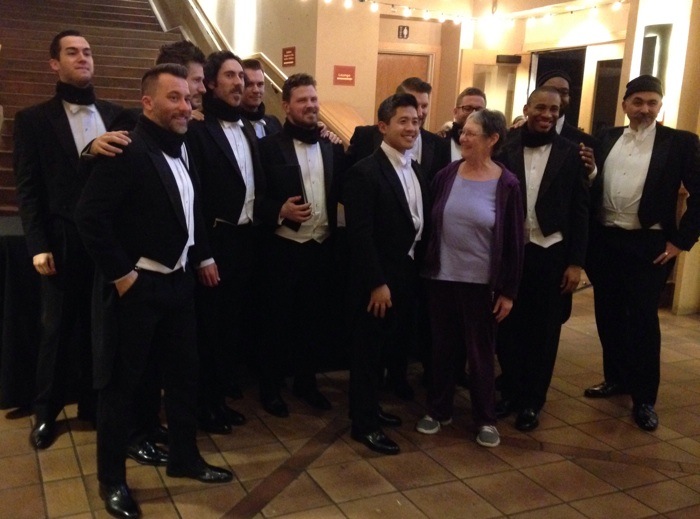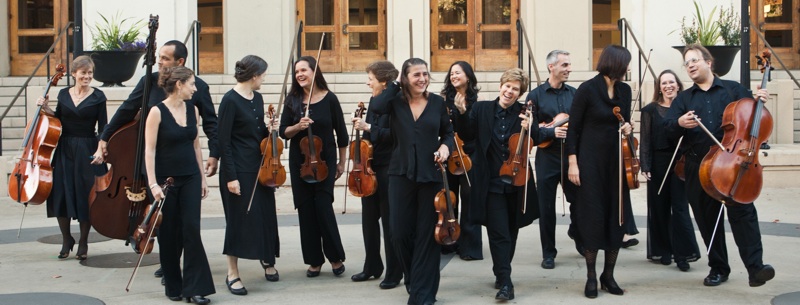Of silken strings and lush voices.
For their spring concert, the expressive strings of New Century Chamber Orchestra joined forces with the exquisite vocals of Chanticleer for a “trip” to Paris, stretching from Ravel’s lush songs to Satie’s austere Gymnopédie and from Gershwin’s early jazz to classic French cabaret.
These two groups are each at the top of their form, and a number of contemporary composers have written or arranged music for them. This journey to the early twentieth century, which they titled “Americans in Paris,” was inspired by the popularity of their first collaboration in 2013, when they brought to the Bay Area the music one would hear (and dance to) during an Atlantic crossing between the World Wars.
Their March 19 Sunday concert in San Rafael was the fourth and closing concert of this new program, and included works in which they both shone separately and songs that combined the two groups. Brazilian composer Clarice Assad has written a number of arrangements for New Century over the last six years, including a fiery violin concerto that she wrote for their concertmaster and Artistic Director, Nadja Salerno-Sonnenberg, and Assad’s arrangements were prominently featured in this concert, too.
They began with Eric Satie’s Gymnopédie No. 1, a deceptively simple piano exercise arranged for string orchestra by Gerard Schwartz. The 19 strings brought languor and poise to each note, grounded in low bass plucks by Erik Higgins – and those notes seemed to take a very long time to die out.
And from that limpid delicacy the violins turned torrid in Albert Roussel’s Allegro from Sinfonietta for Strings, evoking the busy streets of Paris and a soundscape that felt almost sweltering.
The twelve men of Chanticleer took their turn with Maurice Ravel’s Trois Chansons (Three Songs). Their short syllables were as crisp as iceberg lettuce, with diction so perfect that their French was easily understood (or so I was told by someone who actually understood French). “Nicolette” was saucy, “Trois beaux Oiseaux du Paradis” was dreamy, and “Ronde” was acrobatic, with a lovely high moment by countertenor Cortez Mitchell. This is truly the cream of the crop of male vocal groups, and a yardstick by which other groups define themselves, and every aspect of their musicianship showed that. Those rich timbres, perfect entrances and excellent tuning infused each measure, but what was as evident as their hard work was the joy with which they came together and created their sound.
 The voice is an instrument with a wealth of colors and timbres, and further enriched by the shapes of consonants, and these twelve men showed how expressive it could be. Their living sound alternated with the abstracted beauty and emotional fluency of the strings. And contrarily, we were also able to see how “vocal” the strings could be, with spat-out delivery and bowing as fresh as a breath.
The voice is an instrument with a wealth of colors and timbres, and further enriched by the shapes of consonants, and these twelve men showed how expressive it could be. Their living sound alternated with the abstracted beauty and emotional fluency of the strings. And contrarily, we were also able to see how “vocal” the strings could be, with spat-out delivery and bowing as fresh as a breath.
Those strings returned with a lilting neo-classical work, “The Birth of Apollo” from Igor Stravinski’s Apollon Musagète, showing how sweetly those violins can “sing,” and then both groups came together for Gabriel Fauré’s Pavane, arranged by William Fred Scott, Chanticleer’s Music Director. The strings pumped out a gentle rhythmic device, all in pizzicato, while the singers took the melody line in vocalise, each voice naked in its long-held tones but with a steadiness and depth that was remarkable even in the soft high notes. This felt like some extravagant wine, but supped from the air.
Saint-Saëns’ Sérénade d’hiver held an arching and steely delicacy, with a powerful undertow by bass-baritone Marques Jerrell Ruff, and ended with gorgeous hummed fifths, and then the strings returned to accompany them in a medley of French favorites. Here again we were delighted by those two intertwining textures, the warm fibers of voice and the shivery resonance of strings.
In the second half of the program Chanticleer took on some of the great moments of French cabaret, with counter-tenors embodying the playfulness of Blossom Dearie in “Comment allez-vouz” (complete with piquant Manhattan Transfer chords), and the effortless purity of Edith Piaf in their version of her immortal La vie en rose. And Le Chemins de l’Amour had lush harmonies, clean intervals and coy vowels.
Then, together with the strings, they pumped out Gershwin and Cole Porter favorites until the present swam in some golden past.
Salerno-Sonnenberg is stepping down from her position as Artistic Director after this season, and she cut the applause short to tell us this was her last appearance at the Marin Jewish Community Center Theater. “My time playing with this group is at an end,” she said and paused to shake the tears out of her eyes. “And as for Chanticleer, we actually like each other as much as it seems! …After performing in Berkeley we would go to Top Dog for hotdogs, and so these musicians got me this Top Dog baseball cap – because I’m their Top Dog!” She put the cap on, sat down and led a fierce encore, and the audience clapped along.
New Century celebrates its 25th Anniversary with three extraordinary concerts. On May 16 they will honor Nadja’s visionary “Featured Composer” program, with violin concertos written for her and NCCO by some of our generation’s best-known composers: Clarice Assad, William Bolcom, Ellen Taaffe Zwilich, Lera Auerbach, Mark O’Connor, Jennifer Higdon, and Michael Daugherty.
Then on May 18 they will perform an old and new pillar of the violin repertoire: Vivaldi’s Four Seasons and Piazzolla’s Four Seasons of Buenos Aires, two blistering works that are Nadja’s signatures.
And finally on May 20 Nadja and New Century will have an all-Gershwin extravaganza. More information at www.ncco.org
—Adam Broner
Photo, top, of Chanticleer greeting audience members after their concert; photo below of New Century Chamber Orchestra, photo by Matthew Washburn.

